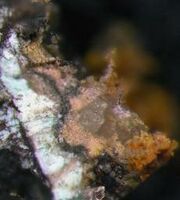Copper oxalate
Jump to navigation
Jump to search
Description
Light blue crystals formed by Oxalic acid interaction with metallic Copper. It has been identified as a corrosion product in the patina of the horses of San Marco in Venice (Rosetti and Marabelli 1976). Copper oxalate has also been found a biomineral formed by the action of lichens on cupriferous rocks. The copper oxalate mineral, moolooite, is named after the Mooloo Downs station in Western Australia where it was found in 1986.
Synonyms and Related Terms
copper(II) oxalate; moolooite; Kazach turquoise
Risks
- CDH Fine Chemicals: SDS
Physical and Chemical Properties
- Composition = Cu(C2O4)·H2O
- Description = light blue to turquoise
- Luster = waxy, dull
- Insoluble in water
- Melting point = 310 C
- Density = 3.43 g/ml
- Hardness = 2.5-3
Resources and Citations
- V. Alumno-Rosetti, M. Marabelli. 'Analysis of the Patina of a Gilded Horse of the St. Mark's Basilica in Venice: Corrosion Mechanism and Conservation Problems". Studies in Conservation 12(4):161-70, 1976.
- Wikipedia: Copper oxalate Accessed Dec 2022
- Frank-Kamenetskaya OV, Zelenskaya MS, Izatulina AR, Vereshchagin OS, Vlasov DY, Himelbrant DE, Pankin DV. Copper oxalate formation by lichens and fungi. Sci Rep. 2021 Dec 20;11(1):24239 Link Note: This article contains XRD and Raman spectra of moolooite.
- Mindat: Moolooite
- Webmineral: Moolooite
